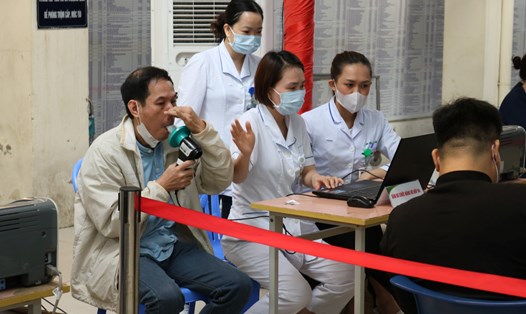Persistent pain after a sudden fall
During recess, 8-year-old N.G.B in Hanoi was unfortunately accidentally knocked down by a friend and had his chest hit hard on the floor. The collision caused the child to have pain in the right rib and feel short of breath. Thinking that it was just a minor injury, the family massageed him with oil to relieve the pain. However, the pain did not subside but became more and more severe. After 3 days, realizing the abnormality, the family took the baby to the Central Hospital for Tropical Diseases for examination.
In the Department of Pediatrics, the X-ray and ultrasound results surprised the whole family: the image was 1/2 white and cleared from the right sub-lyngus, with afulusion of the pleural cavity accompanied by a large fluid follicle. further computer-based imaging discovered a collapsed lung in the lower right mediastinum and a tumor in the frontal fluid follicular cavity measuring up to 72x80mm.
Unintentional fall helps detect dangerous congenital diseases
Doctor Nguyen Thanh Le - Deputy Head of the Department of Pediatrics, Central Hospital for Tropical Diseases - commented: "In fact, the bulge of the fluid has existed before but has not shown symptoms. The fall was just a coincidence that caused the tumor to rupture, making the symptoms more obvious. If not detected early, the disease will continue silently and be at risk of threatening life".
Immediately after diagnosis, the patient was sucked into a pleural secretion to reduce the pressure of compression on the lungs, and given anti-inflammatory treatment. Doctors also consulted to determine the child with a cyst - a rare congenital disease in the chest.
A front mediastinal cyst is a type of stem cell tumor that can be benign or malignant. If not removed promptly, the tumor is at increased risk of developing, causing infection, collapsing the lungs, and even cancer.
After careful assessment, the doctors decided to perform minimalsive vsS surgery to completely remove the tumor. This method helps the surgical wound to be smaller, reduces pain, shortens recovery time and minimizes complications compared to traditional open surgery.
The surgery lasted 2 hours, facing many challenges because the tumor was inflamed and attached to the diaphragm, chest and lung walls. Although it was impossible to isolate the lungs on the surgical side, the surgical team coordinated closely to completely treat the tumor. As a result, baby B's lung cavity was completely cleaned, with no signs of infection. After only 3 days, the child recovered well, ate normally, walked normally and soon returned to normal life.










